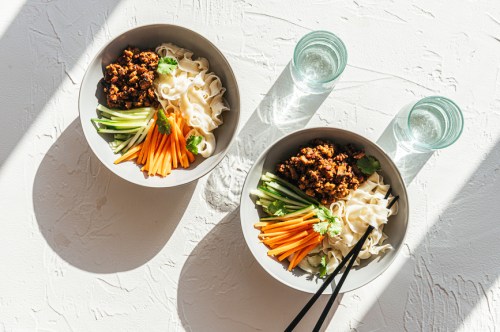Our editors independently select these products. Making a purchase through our links may earn Well+Good a commission
Why Eating Foods That Are Culturally Relevant to You Is Profoundly Important for Your Health, According to an RD
Maya Feller, RD, shares why prioritizing cultural foods is so key for your health in honor of her new cookbook, Eating From Our Roots.

Each of us has patterns of eating that are, in many ways, routinized and repetitive. In addition, we have all adopted our own ideas about what foods get categorized as “healthy” and often have binary thinking about “good” and “bad” foods.
Experts in This Article
Maya Feller, MS, RD, CDN of Brooklyn-based Maya Feller Nutrition is a registered dietitian nutritionist who works with patients looking for nutritional management of diet related chronic illnesses with medical nutrition therapy. She is also adjunct faculty at New York University. Maya is dedicated to promoting nutrition education that helps the public to make informed food choices that support health and longevity.
Our ideas are shaped by cultural norms. In the United States, dominant wellness culture centers Anglo-American and Anglo-European foodways in relation to healthy eating.
When I was studying to become a registered dietitian, our textbooks used the plate method as the gold standard for eating: We were trained to encourage patients to build a plate that was 50 percent non-starchy vegetables, 25 percent lean protein, and 25 percent starch. The images of the ideal plate were often of brown rice, grilled chicken, and broccoli. Objectively, there is nothing “wrong” with this plate; it does have a nice macronutrient balance and would supply fiber along with vitamins and minerals.
Subjectively, however, the challenge is that this so-called “gold standard” plate is based on one particular pattern of eating. When gold standards are created based on dominant Anglo-American definitions of healthy eating, every other culture and its subsequent cuisines are not represented. In addition, it is an insidious way of placing value on Anglo-American wellness culture.
There are plenty of people who do not find brown rice, grilled chicken, and broccoli culturally relevant and would not gravitate towards that as a “healthy” meal. I’ve had patients tell me that they feel shame and guilt when eating their cultural foods because they don’t find these recommended (and exceedingly limited) “healthy” food options to be appealing. In turn, these folks feel that they have fallen short, and they often experience feelings of guilt because they’ve been called out for not meeting the recommendations for fruit and vegetable intake.
From a statistics perspective, the majority of the people living in the United States don’t eat the recommended amount of fruits, vegetables, or fiber. It always gives me pause when I reflect on these numbers as they relate to health outcomes. I can’t help but think about the various systems that are in place, which give some populations the privilege of access to a variety of nourishing foods, while others have a dearth of options. There is no straightforward answer.
My patients have taught me that when they are able to include foods that are culturally relevant to them, they are more likely to regularly include the fruits, vegetables, and starches that they know and love as a consistent part of their pattern of eating. For instance, cod fish and plantains, a delicious breakfast enjoyed in parts of the Caribbean, is almost never mentioned as a healthy option—highly unfortunate, seeing as it is a wonderfully nourishing dish often made with veggies and fresh herbs. Curried chickpeas and potatoes, eaten in the islands of Trinidad and Tobago, Guyana, and Jamaica, are also nutrient-rich and delicious; same goes with black rice from Haiti (made from soaking mushrooms and then cooking the rice with fresh spices).
My patients have taught me that when they are able to include foods that are culturally relevant to them, they are more likely to regularly include the fruits, vegetables, and starches that they know and love as a consistent part of their pattern of eating.
These foods are often not included in dominant health conversations—regardless of the fact that they are incredibly nourishing and health-promoting. In my just-released cookbook, Eating From Our Roots, I examine the importance of eating foods that are culturally-relevant. Many traditional and heritage dishes are based on foods in their whole and minimally-processed form. And in addition to being nutritious, these foods are familiar and bring pleasure and joy to the table. Each of these factors—yes, especially joy—is a key part of maintaining a well-balanced diet.
Incorporating a variety of foods from cultures around the globe provides an opportunity to expand one’s eating repertoire while reframing definitions of healthy eating.
In writing this, I hope to call attention to the microinvalidation that often happens with authoritative declarations in the food space. I also hope to inspire you, the reader, eater, and home cook, to consider your own heritage foods as well as new fruits, vegetables, grains, or spices that can add flavor, color, texture, and exploration of new cultures to your plate. Because life is better when it’s lived deliciously.









